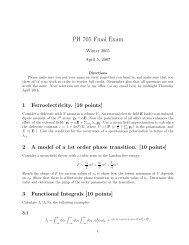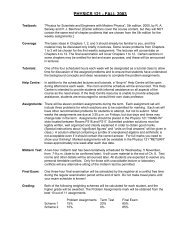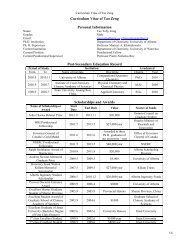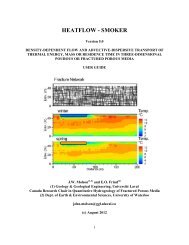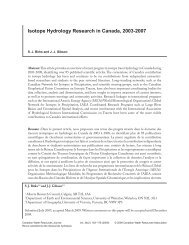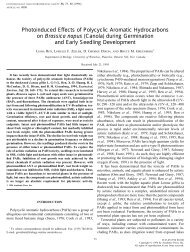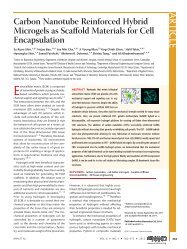POLYMIN - University of Waterloo
POLYMIN - University of Waterloo
POLYMIN - University of Waterloo
Create successful ePaper yourself
Turn your PDF publications into a flip-book with our unique Google optimized e-Paper software.
<strong>POLYMIN</strong> 2005<br />
Background aqueous chemistry<br />
The background (initial) aqueous chemistry data for <strong>POLYMIN</strong> is contained in the file<br />
bckgrndpoly.min. An example <strong>of</strong> this file is included at the end <strong>of</strong> this section.<br />
There is one line for the each <strong>of</strong> the background component values. The first variable on these<br />
lines is idx(nnn) [I] , the component I.D. number (see the comp.dbm data file or Felmy et al.<br />
1984), the second variable is T(nnn) [R], the total analytical component concentration in<br />
moles/kg, or for the case <strong>of</strong> an adsorbed component the concentration <strong>of</strong> the surface sites in eq/l.<br />
The third variable is gx(nnn) [R], the guess for the log <strong>of</strong> the activity for the component , use<br />
zero if a good initial guess is not known and for H + and e - components use the pH and pe values<br />
respectively. The final variable <strong>of</strong> these lines is stad(nnn) [R], the reaction stoichiometry for the<br />
adsorbed phase components (i.e. Na-S); for dissolved components, enter zero.<br />
The total component concentrations (T(nnn)) are determined from the chemical analysis <strong>of</strong> the<br />
solutions <strong>of</strong> interest. Often the chemistry will have to be modified to be used in MINTRAN or<br />
<strong>POLYMIN</strong> by MINTEQA2. This would have to be done for one <strong>of</strong> the following reasons: for a<br />
solution <strong>of</strong> known pH, the initial proton condition must be determined by fixing the pH to give<br />
the initial value for the total analytical concentration <strong>of</strong> H + component, for the simulation <strong>of</strong><br />
redox reactions, the distribution <strong>of</strong> the multi-valence elements must be predetermined from the<br />
solution pe (same procedure as fixing the pH) and e- (idx=1) must be included as a component<br />
(T=0.0), and a type 6 reaction, and for ion-exchange reactions the dissolved and adsorbed phases<br />
must both be included as components with the initial surface site concentration <strong>of</strong> the adsorbed<br />
phase determined from the cation exchange capacity (CEC) and the individual selectivity<br />
coefficients <strong>of</strong> the ion-exchange reactions (K s ). For ion-exchange reactions, the thermodynamic<br />
data base (file thermo.dbm) must be modified. Finally, chemical analyses are generally not<br />
perfectly charge balanced and it is advised that the initial background chemistry be charge<br />
balanced with a non reactive anion or cation. In summary, run the chemical data through<br />
MINTEQA2 and use the equilibrated results as input into MINTRAN or <strong>POLYMIN</strong>.<br />
33




